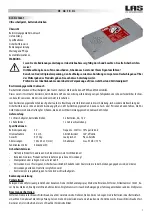
8.3 Basics - Terms
A network res. LAN (Local Area Network) provides a link between different stations that
enables them to communicate with each other. Network stations consist of PCs, IPCs,
TCP/IP adapters, etc. Network stations are separated by a minimum distance and con-
nected by means of a network cable. The combination of network stations and the net-
work cable represent a complete segment. All the segments of a network form the
Ethernet (physics of a network).
In the early days of networking the Triaxial- (yellow cable) or thin Ethernet cable (Cheap-
ernet) was used as communication medium. This has been superseded by the twisted-
pair network cable due to its immunity to interference. The CPU has a twisted-pair con-
nector. The twisted-pair cable consists of 8 cores that are twisted together in pairs. Due to
these twists this system is provides an increased level of immunity to electrical interfer-
ence. For linking please use twisted pair cable which at least corresponds to the category
5. Where the coaxial Ethernet networks are based on a bus topology the twisted-pair net-
work is based on a point-to-point scheme. The network that may be established by
means of this cable has a star topology. Every station is connected to the star coupler
(hub/switch) by means of a separate cable. The hub/switch provides the interface to the
Ethernet.
The hub is the central element that is required to implement a twisted-pair Ethernet net-
work. It is the job of the hub to regenerate and to amplify the signals in both directions. At
the same time it must have the facility to detect and process segment wide collisions and
to relay this information. The hub is not accessible by means of a separate network
address since it is not visible to the stations on the network. A hub has provisions to inter-
face to Ethernet or to another hub res. switch.
A switch also is a central element for realizing Ethernet on Twisted Pair. Several stations
res. hubs are connected via a switch. Afterwards they are able to communicate with each
other via the switch without interfering the network. An intelligent hardware analyses the
incoming telegrams of every port of the switch and passes them collision free on to the
destination stations of the switch. A switch optimizes the bandwidth in every connected
segment of a network. Switches enable exclusive connections between the segments of
a network changing at request.
Network (LAN)
Twisted Pair
Hub (repeater)
Switch
System 300S
+
Deployment Ethernet communication - productive
Basics - Terms
HB140 | CPU | 315-4PN23 | en | 18-02
103
















































